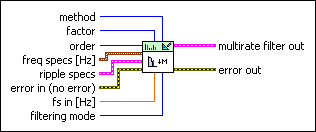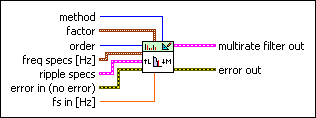DFD MRate Filter Design VI
Owning Palette: Multirate Filter Design VIs
Installed With: Digital Filter Design Toolkit
Creates a single-stage multirate filter. You must manually select the polymorphic instance you want to use.
Use the pull-down menu to select an instance of this VI.
 Place on the block diagram Place on the block diagram |  Find on the Functions palette Find on the Functions palette |
DFD MRate Filter Design (Integer)

 | method specifies the method this VI uses to create the filter.
| ||||||
 | factor specifies the sampling frequency conversion factor of the multirate filter. The value of factor must be an integer greater than zero. The default is 8. | ||||||
 | order specifies the filter order. The value of order must be an even integer that is greater than zero. If order is not greater than zero, this VI uses the ripple specs input to estimate filter order. If order is an odd number, this VI returns an error. The default is –1. | ||||||
 | freq specs specifies the passband edge frequency and stopband edge frequency of the multirate filter.
| ||||||
 | ripple specs specifies the ripple level in the passband and stopband of the filter.
| ||||||
 | error in describes error conditions that occur before this VI or function runs.
The default is no error. If an error occurred before this VI or function runs, the VI or function passes the error in value to error out. This VI or function runs normally only if no error occurred before this VI or function runs. If an error occurs while this VI or function runs, it runs normally and sets its own error status in error out. Use the Simple Error Handler or General Error Handler VIs to display the description of the error code. Use error in and error out to check errors and to specify execution order by wiring error out from one node to error in of the next node.
| ||||||
 | fs in specifies the input sampling frequency of the multirate filter in hertz. The default is 800. | ||||||
 | filtering mode specifies the processing mode of the filter that this VI creates.
| ||||||
 | multirate filter out returns a new multirate filter. | ||||||
 | error out contains error information. If error in indicates that an error occurred before this VI or function ran, error out contains the same error information. Otherwise, it describes the error status that this VI or function produces.
Right-click the error out front panel indicator and select Explain Error from the shortcut menu for more information about the error.
|
DFD MRate Filter Design (Rational)

 | method specifies the method this VI uses to create the filter.
| ||||||
 | factor contains the sampling frequency conversion factor of the multirate filter.
| ||||||
 | order specifies the filter order. The value of order must be an even integer that is greater than zero. If order is not greater than zero, this VI uses the ripple specs input to estimate filter order. If order is an odd number, this VI returns an error. The default is –1. | ||||||
 | freq specs specifies the passband edge frequency and stopband edge frequency of the multirate filter.
| ||||||
 | ripple specs specifies the ripple level in the passband and stopband of the filter.
| ||||||
 | error in describes error conditions that occur before this VI or function runs.
The default is no error. If an error occurred before this VI or function runs, the VI or function passes the error in value to error out. This VI or function runs normally only if no error occurred before this VI or function runs. If an error occurs while this VI or function runs, it runs normally and sets its own error status in error out. Use the Simple Error Handler or General Error Handler VIs to display the description of the error code. Use error in and error out to check errors and to specify execution order by wiring error out from one node to error in of the next node.
| ||||||
 | fs in specifies the input sampling frequency of the multirate filter in hertz. The default is 100. | ||||||
 | multirate filter out returns a new multirate filter. | ||||||
 | error out contains error information. If error in indicates that an error occurred before this VI or function ran, error out contains the same error information. Otherwise, it describes the error status that this VI or function produces.
Right-click the error out front panel indicator and select Explain Error from the shortcut menu for more information about the error.
|
Example
Refer to the Single Stage Multirate Filter Design VI in the labview\examples\Digital Filter Design\Floating-Point Filters\Multirate directory for an example of using the DFD MRate Filter Design VI.




